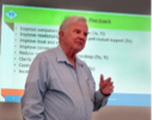| On May 9th, BAAPT held our last regular monthly meeting for the 2014-15 program year, welcoming Bob McAlpine, President and Owner of Type Resources. Bob led morning and afternoon sessions, each of which promoted a deeper understanding and appreciation of the eight functions: the introverted and extroverted manifestations of S-N-T-F. |
Central to discussions in both the morning and afternoon was the understanding of dynamic interactions of type preference in problem solving and in sharing feedback.
The morning session focused on how the eight functions are needed to do effective problem solving. Bob called on his more than 20 years as a leader and trainer of officers in the US Army. He presented the Army’s phased problem solving model, stressing the importance of getting agreements with key stakeholders on a series of issues that lead to actionable results: What’s the problem? What’s the cause of the problem? What are the alternative solutions? What criteria will we use to assess the alternatives? What is the best solution? How will we implement the selected course of action?
At every stage of the process and at every decision point, an appreciation of the contributions of each of the eight functions is crucial. Problem definition and alternative generation require multiple perspectives; if we don’t know the preferences and key criteria of the final decision makers, both time and effort can be wasted. Our type preferences will drive our comfort with the activities and each problems solving phase, so understanding of type will greatly enhance the facilitation of stakeholder engagement.
The afternoon was devoted to use of the eight functions in giving and receiving effective feedback. Bob introduced the concept of two important types of “opposites” between type preferences: “Dynamic Opposites”, where the attitudinal/outside letters of one person’s type code are the same as another person, but the inner pair of functional letters are the opposites (e.g. ENFP/ESTP), and “Opposing Personalities” where the inner functional pair is the same and the attitudinal pair is opposite (e.g. ENFP/INFJ). In these two “opposite” type pairings, some of the functions associated with conscious archetypes in one person occupy unconscious archetypes in the other and can lead to either miscommunication if not understood, or an opportunity to avoid blind spots if the differences are embraced.
We came away from both sessions with a deeper appreciation for the importance of type dynamics.
-- Vic Ortiz
At every stage of the process and at every decision point, an appreciation of the contributions of each of the eight functions is crucial. Problem definition and alternative generation require multiple perspectives; if we don’t know the preferences and key criteria of the final decision makers, both time and effort can be wasted. Our type preferences will drive our comfort with the activities and each problems solving phase, so understanding of type will greatly enhance the facilitation of stakeholder engagement.
The afternoon was devoted to use of the eight functions in giving and receiving effective feedback. Bob introduced the concept of two important types of “opposites” between type preferences: “Dynamic Opposites”, where the attitudinal/outside letters of one person’s type code are the same as another person, but the inner pair of functional letters are the opposites (e.g. ENFP/ESTP), and “Opposing Personalities” where the inner functional pair is the same and the attitudinal pair is opposite (e.g. ENFP/INFJ). In these two “opposite” type pairings, some of the functions associated with conscious archetypes in one person occupy unconscious archetypes in the other and can lead to either miscommunication if not understood, or an opportunity to avoid blind spots if the differences are embraced.
We came away from both sessions with a deeper appreciation for the importance of type dynamics.
-- Vic Ortiz

 RSS Feed
RSS Feed





